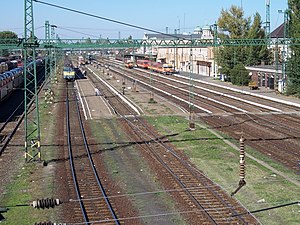Szolnok – Arad railway line
| Szolnok – Arad | |||||||||||||||||||||||||||||||||||||||||||||||||||||||||||||||||||||||||||||||||||||||||||||||||||||||||||||||||||||||||||||||||||||||||||||||||||||||||||||||||||||||||||||||||||||||||
|---|---|---|---|---|---|---|---|---|---|---|---|---|---|---|---|---|---|---|---|---|---|---|---|---|---|---|---|---|---|---|---|---|---|---|---|---|---|---|---|---|---|---|---|---|---|---|---|---|---|---|---|---|---|---|---|---|---|---|---|---|---|---|---|---|---|---|---|---|---|---|---|---|---|---|---|---|---|---|---|---|---|---|---|---|---|---|---|---|---|---|---|---|---|---|---|---|---|---|---|---|---|---|---|---|---|---|---|---|---|---|---|---|---|---|---|---|---|---|---|---|---|---|---|---|---|---|---|---|---|---|---|---|---|---|---|---|---|---|---|---|---|---|---|---|---|---|---|---|---|---|---|---|---|---|---|---|---|---|---|---|---|---|---|---|---|---|---|---|---|---|---|---|---|---|---|---|---|---|---|---|---|---|---|---|---|
|
Railway station in Békéscsaba
| |||||||||||||||||||||||||||||||||||||||||||||||||||||||||||||||||||||||||||||||||||||||||||||||||||||||||||||||||||||||||||||||||||||||||||||||||||||||||||||||||||||||||||||||||||||||||
| Course book range : | CFR: 200, MÁV: 120 | ||||||||||||||||||||||||||||||||||||||||||||||||||||||||||||||||||||||||||||||||||||||||||||||||||||||||||||||||||||||||||||||||||||||||||||||||||||||||||||||||||||||||||||||||||||||||
| Route length: | 153 km | ||||||||||||||||||||||||||||||||||||||||||||||||||||||||||||||||||||||||||||||||||||||||||||||||||||||||||||||||||||||||||||||||||||||||||||||||||||||||||||||||||||||||||||||||||||||||
| Gauge : | 1435 mm ( standard gauge ) | ||||||||||||||||||||||||||||||||||||||||||||||||||||||||||||||||||||||||||||||||||||||||||||||||||||||||||||||||||||||||||||||||||||||||||||||||||||||||||||||||||||||||||||||||||||||||
| Power system : | 25 kV 50 Hz ~ ~ | ||||||||||||||||||||||||||||||||||||||||||||||||||||||||||||||||||||||||||||||||||||||||||||||||||||||||||||||||||||||||||||||||||||||||||||||||||||||||||||||||||||||||||||||||||||||||
| Top speed: | 160 km / h | ||||||||||||||||||||||||||||||||||||||||||||||||||||||||||||||||||||||||||||||||||||||||||||||||||||||||||||||||||||||||||||||||||||||||||||||||||||||||||||||||||||||||||||||||||||||||
|
|||||||||||||||||||||||||||||||||||||||||||||||||||||||||||||||||||||||||||||||||||||||||||||||||||||||||||||||||||||||||||||||||||||||||||||||||||||||||||||||||||||||||||||||||||||||||
The Szolnok – Arad railway is a main line in Hungary and Romania , which was originally built and operated by the kk privileged Theiss Railway . It runs in the east of the Great Hungarian Plain .
history
When it was built, the railway line was on the territory of Hungary within the Habsburg dual monarchy . The line was built as part of the scheduled development of the eastern part of the Great Hungarian Plain, after the railway from Budapest to Szolnok was opened in 1847 and that from Szolnok to Debrecen in 1857 .
On November 10, 1856, the Austro-Hungarian government granted the kk privileged Theiss Railway (Hungarian: Tiszavidéki vasút ) - a private railway company - a 90-year concession for the construction and operation of the railway line beginning on January 1. One condition was to complete the line by the end of 1859.
The railway line connected a few kilometers east of Szolnok in the village of Szajol to the existing line from Szolnok to Debrecen. 37 wooden bridges had to be built for the construction, of which the one over the Körös (German Kreisch ) was the longest.
The line was opened on October 25, 1858 and initially operated by the Theissbahn. After the Austro-Hungarian Compromise in 1867, part of the shares in the railway company were taken over by the Hungarian state; In 1880 it was completely nationalized.
After the end of the First World War , the south-eastern part of the route described here came to Romania and was taken over by the state railway company CFR . Since then there are border stations in Lőkösháza and Curtici .
Todays situation
The line is electrified and double-tracked to Békéscsaba. It is single-track between Békéscsaba and Curtici (Romanian border). It is one of the most important and efficient connections between Hungary and Romania and part of the two TEN-T core network corridors Danube and Orient / Östl. Mediterranean Sea. Several express and local trains run daily. The line is also of great importance for freight traffic between Romania and the countries of Central and Western Europe.
The modernization of the railway line with continuous double-track expansion (design speed 160 km / h) should be completed on the Romanian side in 2014, but a delay in the completion date is considered likely.
Web links
Individual evidence
- ^ Adalbert Theodor Michel : Oesterreichs Eisenbahnrecht. Verlag W. Braumüller, 1860. p. 9
- ^ Julius Michaelis: Germany's railways. Verlag CF Amelang, 1859. pp. 357-361
- ^ Peter Friedrich Kupka: The Austrian-Hungarian Railways 1822-1867. Duncker & Humblot Publishers, 1888. p. 274
- ^ Adam Wandruszka et al .: The Habsburg Monarchy, 1848–1918: Economic development. Publishing house of the Austrian Academy of Sciences, 1973. p. 296
- ↑ http://www.cfr.ro/files/proiecte/FC/Date_site-km%20614.pdf
- ↑ http://www.mav.hu/mav/fejlesztes.php?mid=14ef35099372e8
- ↑ http://www.agerpres.ro/economie/2014/05/09/ministrul-sova-a-cerut-control-la-lucrarile-intarziate-pe-coridorul-iv-feroviar-15-57-08

